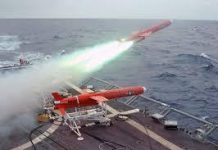
On July 9, 2025, France announced it will restart production of the SCALP/Storm Shadow cruise missile after a 15-year break, signaling a renewed Franco-British effort to bolster Europe’s defense capabilities. The announcement, made during a visit to MBDA’s Stevenage facility in the UK alongside British Defense Secretary John Healey, highlights the increasing need for precision strike weapons, particularly in light of the ongoing war in Ukraine.
The move reflects growing pressure on European nations to restock advanced munitions and reduce reliance on non-European suppliers. The SCALP/Storm Shadow has proven highly effective in Ukraine, where it has been used to strike critical Russian military infrastructure with high accuracy.
Jointly developed by France and the UK, the missile is designed for long-range, high-precision strikes against fortified targets. Measuring roughly 16.7 feet in length and weighing about 2,866 pounds, it carries a 992-pound BROACH warhead capable of penetrating hardened defenses. Depending on the version, its range varies from over 155 miles (export) to around 348 miles (non-export), allowing it to be launched from well beyond enemy air defenses.
Guidance is provided by a blend of GPS, inertial navigation, terrain-following TERPROM, and an infrared seeker for terminal targeting. These systems allow the missile to fly low and evade detection while navigating complex terrain. It is compatible with multiple aircraft, including France’s Rafale, the UK’s Typhoon, and Ukraine’s upgraded Su-24M bombers, offering flexibility across NATO and partner air forces.
Compared to the U.S.-built AGM-158 JASSM, which costs about $1.2 million, the SCALP/Storm Shadow is slightly more cost-effective at around $1 million per unit, offering similar capabilities for a lower price—an appealing proposition for NATO members.
The missile has seen extensive operational use since its combat debut in 2003 during the Iraq War, where British forces used it against heavily defended bunkers. It was also deployed in Libya in 2011 by both France and the UK during NATO operations. Since 2023, Ukraine has employed the weapon with significant success, coordinating strikes with drones to overwhelm Russian air defenses. Notably, a July 2025 strike in Donetsk reportedly hit a key Russian command center, demonstrating the missile’s continued relevance.
Unlike Russia’s Kh-101, which lacks stealth features, the SCALP/Storm Shadow’s low-observable design allows it to bypass systems like the S-300, enhancing its survivability in contested environments.
France’s decision comes as European nations struggle to replace munitions sent to Ukraine. According to the French Institute of International Relations, France hasn’t replenished its SCALP stockpile since 2023. MBDA, a joint venture involving France, the UK, Germany, and Italy, has since invested in modernizing its facilities, adding automation and new shifts to double output compared to two years ago. MBDA CEO Éric Béranger told the Financial Times the company is on track to meet growing demand.
Still, challenges remain. Some MBDA partner nations are cautious about structural changes that could affect their influence within the company, according to reporting from Caliber.Az. Such concerns highlight the complexity of multinational defense ventures.
The production restart reflects a broader geopolitical recalibration. The prolonged war in Ukraine has strained Western military inventories, especially for precision-guided munitions. Since mid-2023, the UK and France have provided Storm Shadow and SCALP missiles to Ukraine, allowing strikes deep into Russian-held areas, including Crimea. A joint decision by the US and UK in late 2024 authorized Ukraine to use these missiles on Russian soil, escalating tensions but also accelerating Western stockpile depletion.
In response, the UK Ministry of Defence stated in January 2025 that NATO allies would be prioritized for resupply, implying a pause in transfers until production ramps up.
Under France’s military spending plan for 2024–2030, $268 billion has been earmarked for defense programs, including $69 million for MBDA’s missile systems, according to Militaer Aktuell. This investment aims not only to meet immediate needs but also to strengthen long-term European defense autonomy.
France and the UK are also jointly developing a successor to the SCALP/Storm Shadow, known as the Future Cruise/Anti-Ship Weapon (FC/ASW), expected to be fielded between 2028 and 2034. This next-generation missile is designed to overcome emerging air defense threats, such as Russia’s S-400, through improved speed and maneuverability.
MBDA is additionally exploring a new concept called the “One Way Effector,” which could be produced at a much higher scale—up to 1,000 units per month—and strike targets up to 500 kilometers away. This shift toward high-volume, cost-effective production contrasts with the current limited production rate of the SCALP/Storm Shadow. For comparison, the U.S. manufactures around 600 PAC-3 MSE interceptors annually, aiming to boost this to 650 by 2027, illustrating the gap in production capacity.
Ukraine’s successful integration of SCALP/Storm Shadow onto its outdated Su-24M bombers also underscores European adaptability. According to analyst Justin Bronk, these aircraft likely rely on pre-set coordinates due to lacking modern targeting radars. While this workaround has proven effective, it also highlights Ukraine’s reliance on Western aid for sustained operations.
Meanwhile, Russia has claimed to intercept several Storm Shadow missiles, such as in a January 2025 incident over Bryansk. However, such claims remain unverified and part of ongoing information warfare.
The economic benefits of resuming production are also notable. MBDA’s upgraded facility in Stevenage will support over 300 UK jobs and contribute to more than 1,300 positions across Franco-British defense collaborations. A newly announced “Entente Industrielle,” unveiled at a July 2025 summit, emphasizes further cooperation on areas such as nuclear deterrence and AI-enhanced weapons systems.
Originally conceived 35 years ago and operational since 2002, the SCALP/Storm Shadow program has remained viable through various upgrades. However, the war in Ukraine has accelerated depletion of these missiles, sparking criticism that European governments should have restarted production much earlier. Commentators, including X user @FRHoffmann1, have pointed to 2022 as a missed opportunity.
The delayed restart reflects broader issues within Europe’s defense ecosystem, including fragmented national interests and dependence on external components—challenges that could affect MBDA’s ability to meet demand at scale.
Ultimately, restarting production represents a crucial step in addressing Europe’s military readiness. It acknowledges the changing nature of warfare, where precision, range, and industrial capacity are paramount. Yet, sustaining this momentum will require coordinated policy, investment, and industrial reform.




